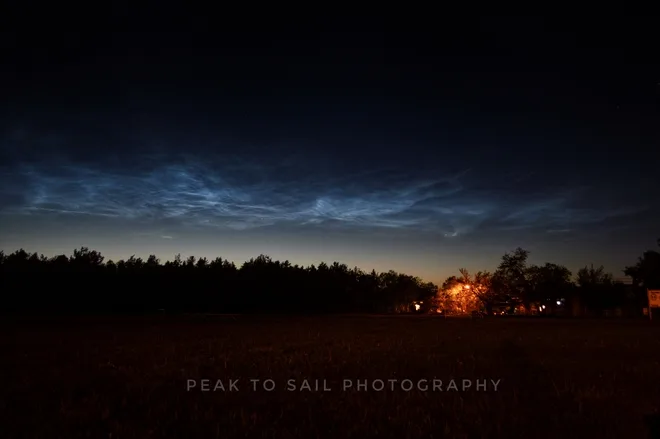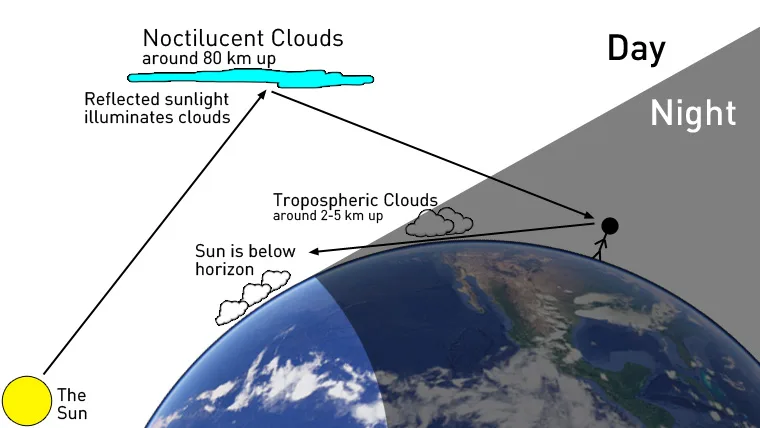
These eerily beautiful clouds are having a big year
Eerily beautiful clouds glowing in the twilight sky are having a banner season in 2019.
Noctilucent clouds (literally, 'night-shining clouds') -- normally an elusive summertime visitor to only the northern fringes of the Northern Hemisphere -- seem to be on the move farther south this summer.
While that makes for some rare and excellent viewing, the reason for the shift is less encouraging.
Early June to mid-July is prime time for noctilucent clouds (NLCs) which -- under the right conditions -- appear as wispy, softly glowing streaks in the sky at twilight. While they look a bit like cirrus clouds, they're a breed apart from their everyday cousins.

NLCs above Miramichi, New Brunswick in June 2019. Image courtesy Mike MacLellan
For one thing, they form higher in the atmosphere -- much higher, in fact. While most of the clouds we're familiar with inhabit the troposphere, the lowest layer of the atmosphere, noctilucent clouds (NLCs) dwell in the mesosphere, along with the auroras. That puts them as high as 80 kilometres above the surface.
Their origin is also out of this world (literally). To form a cloud, water vapour needs something to condense on. Down here near the surface there's ample dust, pollen, and other molecules to serve as these condensation points. Up at 80 kilometres, however, it's usually slim pickings (at least, it has been in the past; more on that below). The condensation points for NLCs tend to be volcanic ash that circulates for years following a major eruption (think Krakatoa), or, more often, space debris, like meteoritic dust.
"It's not necessarily directly from meteors that we see flash through the sky," says Weather Network science writer Scott Sutherland. "Earth's atmosphere sweeps up TONS of dust, every day, as the planet orbits the Sun (along with a few bigger bits)."
The clouds are occasionally visible at twilight thanks to light reflected by the setting sun.

Until recently, NLCs have been pretty much restricted to a range between 50º and 70º degrees latitude (or, from just north of the Canada - U.S. border in western Canada to the middle of Baffin Island). Over that span, you're far enough north that the thermosphere is cold enough to allow ice crystals to form, and far enough south that you actually get twilight, as opposed to the Midnight Sun.
This year, however, they seem to be turning up all over the place. In fact, a new 'southern record' for sightings was set in mid-June, when they were spotted near Los Angeles, California. That's nearly 20º latitude further south than typical.
NLCs have also seemingly been more vibrant this year, making the rounds on social media in numerous 'outbreaks' all across Canada, the United States, and Europe.
So why are these, some of Earth's rarest clouds, not as rare as they used to be? As is so often the case, it may be our fault.
NLCs were only first definitively observed in 1885, in central Germany, likely enhanced in the wake of the 1883 eruption of Krakatoa, but sightings have been spreading ever since, picking up speed since the 1960s.
A recent study points to the increase in methane in the atmosphere as the main culprit. Researchers from the Leibniz Institute of Atmospheric Physics found that increased methane drove a rise in water vapour in the mesosphere, making it both easier for the clouds to form, and making them brighter and more visible.
"In recent decades it is likely to see one or more NLC per season," says the team, "whereas the probability was only once per several decades before the beginning of industrialization." And they add that, in historic times, the clouds were likely too infrequent and too hard to see to be noticed and categorized.
Their conclusion? The spread of NLCs, and their sightings, are a "long-term indicator" for climate change.
If you want to track noctilucent cloud sightings in your area, or perhaps catch a glimpse of them yourself, you can follow Noctilucent Cloud Alerts on Twitter.
Sources: Geophysical Research Letters | Sky & Telescope | NASA AIM | RASC | The Verge |
Thumbnail: Noctilucent clouds over Red Deer, Alberta. Image courtesy Jeff Adams.





